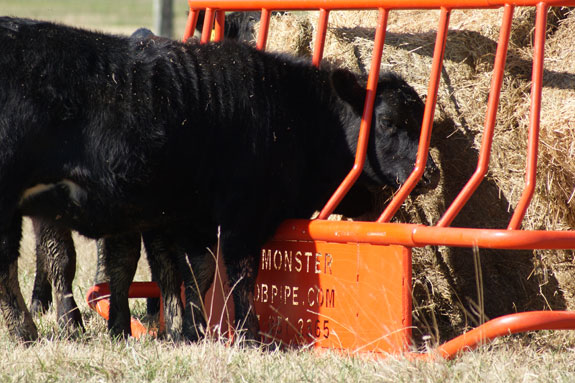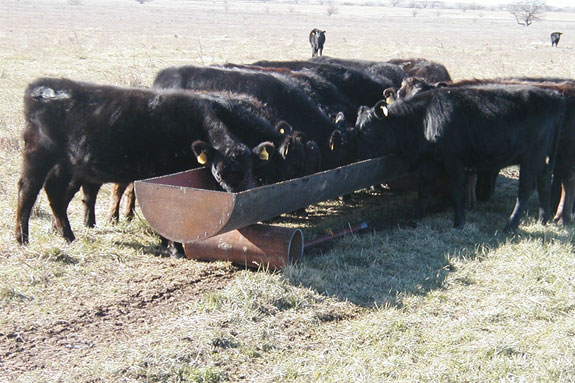Fortunately, new and improved hay feeder and bunk designs are going a long way toward maximizing on-hand stocks of hay so they can last through the winter.
This includes the recent availability of square hay bale feeders (previous options were limited to smaller round bales) designed to conserve up to 33 percent of existing hay resources, new heavy steel feed bunks that are an economical alternative to plastic and concrete and even new shipping techniques designed to drive down freight costs, which are passed on to the farmer.
Saving on feed spillage
Using conventional hay feeding rings, cattle ranchers can lose thousands of dollars per year in avoidable feed loss.
With traditional feeding rings, cattle stand outside the feeder, tear the hay out, and let the excess fall from their mouths. When cattle bite off too much, which they are inclined to do, the hay falls to the ground and gets trampled and otherwise damaged – and will not be eaten.

“Conserver” hay feeders, on the other hand, force cattle to place their heads through metal bars to get at the hay. Any feed the cows drop falls right back into the feeder where it can be eaten later.
The success of the hay conserving bale feeder has led to the recent development and release of new options that accommodate the large square bales popular throughout the Northwest. Large square bales are also popular for feeding dairy cattle in places such as Wisconsin, California and southern Missouri.
“Until recently, there have been no hay conserver feeders available on the market that accommodated the large square bales,” says Bob Studebaker, president of GoBob Pipe and Steel, the supplier that first introduced “Hay Conserver” feeders about six years ago and has subsequently shipped over 9,000 feeders across the U.S. “The square feeders are based on the same principles, so a farmer can save roughly a third of his existing hay resources as well as the time, trouble and cost of locating and transporting additional hay.”
According to Studebaker, hay feeder suppliers are increasingly searching for ways to reduce the overall cost through creative solutions to reduce freight costs. One option is to have feeders shipped partially assembled and unpainted in kits, rather than fully assembled. Strategically located fabricators throughout the country would then handle the final assembly and painting. Customers and dealers can even elect to finish the assembly and painting themselves at a further discount.
“Shipping is a substantial cost that affects the overall cost of the product,” explains Studebaker. “Instead of shipping 25 completed feeders on a semi, we can ship about four times that many in kit form. This significantly reduces shipping costs, so that they can be passed on to the customer.”
Feed bunks
The other option for feeding cattle is feed bunks. Like the hay feeder, there are important considerations that go into the selection of bunk, its construction and how to avoid unnecessary feed waste.
A typical feed bunk from a feed store or farm supply center is 8 to 10 feet long, has a light tubular frame and a plastic trough. Plastic bunks are relatively inexpensive at $110 to $150.
Unfortunately, because they weigh about 50 pounds, cattle can push plastic bunks around the yard. If livestock inadvertently step into the trough they can punch a hole right through the plastic. The cost of replacing damaged bunks over time eliminates much of the savings from the initial purchase price.
The alternative to plastic is concrete. However, concrete bunks require substantial, regular maintenance. Because concrete is porous, it must be sealed on a periodic basis. If not, concrete will spall or chip. Concrete bunks have the additional disadvantage of being so heavy and cumbersome that it is very difficult to move them when necessary.
“Concrete bunks usually weigh a couple of tons and require a tractor to move them,” Studebaker explains. “Plus, if you move them in the winter they can crack, which will allow moisture to get in and freeze. If the bunk ruptures, then it requires repair or replacement.”

A highly efficient and practical alternative to plastic and concrete pasture bunks is the “half pipe” metal feeding bunk. Constructed of a 20 foot metal pipe split in half, these feed bunks are plated to seal the ends, with metal legs welded underneath to provide highly durable legs. The product is also available by the foot for constructing long, fence line bunk systems.
These metal bunks feature a trough that is 5/16-3/8 in. thick, making them virtually indestructible. At a little over 1000 pounds, they are too heavy for cattle to move, but easy enough for the farmer. Although heavy steel bunks cost about 30 percent more than plastic, cattlemen never have to replace them.
In addition to standard metal bunks, there are high-volume “super bunk” models that are designed for those that feed cattle ground hay, silage or other high volume forage.
Constructed of steel plate, instead of a half-pipe, the trough is 34 in. wide and 12 in. deep. To ensure that feed and supplements will not get trapped into square edges or corners and wasted, the sides of the trough are sloped inward toward the bottom. The high-volume bunk also features skids and a tow bar, making it easily transported around the pasture.
Whether bunk or hay feeder, cattle ranchers and dairy farmers would do well to examine the latest options that can help them stretch existing feed resources and eliminate shortfalls that will force them to purchase additional hay at today’s inflated prices. ![]()







